Real-Time Monitoring of Critical Quality Attributes during High-Shear Wet Granulation Process by Near-Infrared Spectroscopy Effect of Water Addition and Stirring Speed on Pharmaceutical Properties of the Granules
Abstract
:1. Introduction
2. Results
2.1. Establishment of PLSR Calibration Models for Evaluating Pharmaceutical Properties of HSWG Granules by NIRS/PLSR
2.2. Regression Vector (RV) of the Best Calibration Models to Predict Pharmaceutical Properties of HSWG Granular Products
2.3. Real-Time-Monitoring of Pharmaceutical Properties of the Granules during HSWG Process Using NIRS
2.4. Effect of CQA of Granulation Process on Critical Product Quality of the HSWG Granules
2.5. Quantitative Relationship between Final Pharmaceutical Properties of HSWG Granules and Critical Process Parameters
3. Discussion
3.1. Evaluation of Pharmaceutical Properties of HSWG Granules by NIR/PLSR Method
3.2. Actual Real-Time Monitoring for Pharmaceutical Properties of the Granules during HSWG Process by NIR/PLSR
3.3. CQA Monitoring for Controlling Critical Product Quality of HSWG Granules by NIR/PLSR
4. Materials and Methods
4.1. Materials
4.2. Granulation
4.3. Evaluation of Micrometrics of Granules
4.4. Measurement of NIRS
5. Conclusions
Author Contributions
Funding
Institutional Review Board Statement
Informed Consent Statement
Data Availability Statement
Conflicts of Interest
Nomenclatures
| ANOVA | one-way analysis of variance |
| cGMP | current good manufacturing practice |
| CF | centrifugal force |
| γ2 | coefficients of determination |
| CQA | critical quality attribute |
| D50 | median particle size |
| FDA | U.S Food and Drug Administration |
| GMP | good manufacturing practice |
| HCA | Hierarchical cluster analysis |
| HSWG | high-shear wet granulation |
| HPC-L | hydroxypropyl cellulose |
| HR | Hauser ratio |
| LA | α-Lactose anhydride |
| LAH | α-Lactose monohydrate |
| LD | loose powder density |
| 1st | first derivative |
| 2nd | second derivative |
| MS | moisture content |
| NIRS | near-infrared spectroscopy |
| NOR | area normalization |
| MSC | multiplicative scatter correction |
| SNV | standard normal variate |
| LOOCV | leave-one-out-cross-validation method |
| LV | latent variables |
| PAT | process analytical technology |
| PLSR | partial least squares regression analysis |
| PS | potato starch |
| PRESS | predicted residual error sum of squares |
| QbA | quality by design |
| RV | regression vector |
| SEP | standard error of prediction |
| SEVC | standard error of calibration |
| SIab | calculated from the multivariate distance between two samples |
| SD | standard deviations |
| SECV | standard error of cross validation |
| TD | tapped density |
References
- Gad, S.C. (Ed.) Pharmaceutical Manufacturing Handbook: Production and Processes; John Wiley & Sons: New York, NY, USA, 2008. [Google Scholar]
- Pandey, P.; Badawy, S. A quality by design approach to scale-up of high-shear wet granulation process. Drug Dev. Ind. Pharm. 2016, 42, 175–189. [Google Scholar] [CrossRef] [PubMed]
- Rantanen, J.; Khinast, J. The future of pharmaceutical manufacturing sciences. J. Pharm. Sci. 2015, 104, 3612–3638. [Google Scholar] [CrossRef] [PubMed] [Green Version]
- Liu, B.; Wang, J.; Zeng, J.; Zhao, L.; Wang, Y.; Feng, Y.; Du, R. A review of high shear wet granulation for better process understanding, control and product development. Powder Technol. 2021, 381, 204–223. [Google Scholar] [CrossRef]
- Shanmugam, S. Granulation techniques and technologies: Recent progresses. BioImpacts BI 2015, 5, 55. [Google Scholar] [CrossRef] [Green Version]
- Guidance for Industry PAT—A Framework for Innovative Pharmaceutical Development, Manufacturing, and Quality Assurance, U.S. Department of Health and Human Servic.s Food and Drug Administration Center for Drug Evaluation and Research (CDER) Center for Veterinary Medicine (CVM) Office of Regulatory Affairs (ORA) Pharmaceutical CGMPs. Available online: Chrome-extension://efaidnbmnnnibpcajpcglclefindmkaj/https://www.fda.gov/media/71012/download (accessed on 2 May 2022).
- Singh, J. International Conference on Harmonization of Technical Requirements for Registration of Pharmaceuticals for Human Use. J. Pharmacol. Pharmacother. 2015, 6, 185–187. [Google Scholar] [CrossRef] [Green Version]
- Lee, L.S.; O’Connor, F.T.; Yang, X.; Cruz, N.C.; Chatterjee, S.; Madurawe, D.R.; Moore MV, C.; Yu, X.L.; Woodcock, J. Modernizing pharmaceutical manufacturing: From batch to continuous production. J. Pharm. Innov. 2015, 10, 191–199. [Google Scholar] [CrossRef] [Green Version]
- Nasr, M.M.; Krumme, M.; Matsuda, Y.; Trout, L.B.; Badman, C.; Mascia, S.; Cooney, L.C.; Jensen, D.K.; Florence, A.; Johnston, C.; et al. Regulatory perspectives on continuous pharmaceutical manufacturing: Moving from theory to practice. J. Pham. Sci. 2017, 106, 3199–3206. [Google Scholar] [CrossRef]
- Chitu, T.M.; Oulahna, D.; Hemati, M. Rheology, granule growth and granule strength: Application to the wet granulation of lactose-MCC mixtures. Powder Technol. 2011, 208, 441–453. [Google Scholar] [CrossRef]
- Faure, A.; York, P.; Rowe, R.C. Process control and scale-up of pharmaceutical wet granulation process: A review. Eur. J. Pharm. Biopharm. 2001, 52, 269–277. [Google Scholar] [CrossRef]
- Leuenberge, H. New trends in the production of pharmaceutical granules: The classical batch concept and the problem of scale-up. Eur. J. Pharm. Biopharm. 2001, 52, 279–288. [Google Scholar] [CrossRef]
- Huang, J.; Kaul, G.; Utz, J.; Hernandez, P.; Wong, V.; Bradley, D.; Nagi, A.; O’grady, D. A PAT approach to improve process understanding of high shear wet granulation through in-line particle measurement using FBRM C35. J. Pharm. Sci. 2010, 99, 3205–3212. [Google Scholar] [CrossRef] [PubMed]
- Arp, Z.; Smith, B.; Dycus, E.; O’grady, D. Optimization of a high shear wet granulation process using focused beam reflectance measurement and particle vision microscope technologies. J. Pharm. Sci. 2011, 100, 3431–3440. [Google Scholar] [CrossRef] [PubMed]
- Gamble, J.F.; Dennis, A.B.; Tobyn, M. Monitoring and end-point prediction of a small scale wet granulation process using acoustic emission. Pharm. Dev. Tech. 2009, 14, 299–304. [Google Scholar] [CrossRef]
- Whitaker, M.; Baker, G.R.; Westrup, J.; Goulding, P.A.; Rudd, D.R.; Belchamber, R.M.; Collins, M.P. Application of acoustic emission to the monitoring and end point determination of a high shear granulation process. Int. J. Pharm. 2000, 205, 79–91. [Google Scholar] [CrossRef]
- Aoki, H.; Hattori, Y.; Otsuka, M. Real-time Monitoring of the Drying of Extruded Granules in a Fluid-bed Dryer Using Audible Acoustic Emission Chemometrics. RSC Adv. 2014, 4, 50558–50565. [Google Scholar] [CrossRef]
- Narang, A.S.; Sheverev, V.; Stepaniuk, V.; Bawdy, S.; Stevens, T.; Macias, K.; Wolf, A.; Pandey, P.; Bindra, D.; Varia, S. Real-time assessment of granule densification in high shear wet granulation and application to scale-up of a placebo and a Brivanib Alaninate formulation. J. Pharm. Sci. 2015, 104, 1019–1034. [Google Scholar] [CrossRef]
- Narang, A.S.; Sheverev, V.; Freeman, T.; Both, D.; Stepaniuk, V.; Delancy, M.; Millington-Smith, D.; Macias, K.; Subramanian, G. Process analytical technology for high shear wet granulation: Wet mass consistency reported by in-line drag flow force sensor is consistent with powder rheology measured by at-line FT4 powder rheometer®. J. Pharm. Sci. 2016, 105, 182–187. [Google Scholar] [CrossRef]
- Kona, R.; Qu, H.; Mattes, R.; Jancsik, B.; Fahmy, R.M.; Hoag, S.W. Application of in-line near infrared spectroscopy and multivariate batch modeling for process monitoring in fluid bed granulation. Int. J. Pharm. 2013, 452, 63–72. [Google Scholar] [CrossRef]
- Alcala, M.; Blanco, M.; Bautista, M.; Gonzárez, J.M. On-line monitoring of a granulation process by NIR spectroscopy. J. Pharm. Sci. 2010, 99, 336–345. [Google Scholar] [CrossRef]
- Burggraeve, A.; Silva Ana, F.T.; Van Den Kerkhof, T.; Hellings, M.; Vervaet, C.; Remon, J.P.; Heyden, Y.V.; De Beer, T. Development of a fluid bed granulation process control strategy based on real-time process and product measurements. Talanta 2012, 100, 293–302. [Google Scholar] [CrossRef] [Green Version]
- Hayashi, Y.; Sato, T.; Otsuka, M. Real-time monitoring of the drying of extruded-granules in a fluidized bed using near infrared spectroscopy and kinetic evaluation of the drying process. J. Near-Infrared Spec. 2013, 21, 107–115. [Google Scholar] [CrossRef]
- Otsuka, M.; Koyama, A.; Hattori, Y. Real-time release monitoring for water content and mean particle size of granules in lab-sized fluid-bed granulator by near-infrared spectroscopy. RSC Adv. 2014, 4, 17461–17468. [Google Scholar] [CrossRef]
- Otsuka, M.; Kanai, Y.; Hattori, Y. Real-time monitoring of changes of absorbed and crystalline water contents in tablet formulation powder containing Theophylline Anhydrate at various temperatures during agitated granulation by near-infrared spectroscopy. J. Pharm. Sci. 2014, 103, 2924–2936. [Google Scholar] [CrossRef] [PubMed]
- Blanco, M.; Cueva-Mestanza, R.; Peguero, A. Controlling individual steps in the production process of paracetamol tablets by use of NIR spectroscopy. J. Pharm. Biomed. Anal. 2010, 51, 797–804. [Google Scholar] [CrossRef]
- Jørgensen, A.C.; Luukkonen, P.; Rantanen, J.; Schæfer, T.; Juppo, A.M.; Yliruusi, J. Comparison of torque measurement and near-infrared spectroscopy in characterization of a wet granulation process. J. Pharm. Sci. 2004, 93, 2232–2243. [Google Scholar] [CrossRef]
- Otsuka, M. Chemoinfometrical evaluation of granule and tablet properties of pharmaceutical preparations by near-infrared spectroscopy. Chemom. Intell. Lab. Syst. 2006, 82, 109–114. [Google Scholar] [CrossRef]
- Wu, S.; Panikar, S.S.; Singh, R.; Zhang, J.; Glasser, B.; Ramachandran, R. A systematic framework to monitor mulling processes using near infrared spectroscopy. Adv. Powder Technol. 2016, 27, 1115–1127. [Google Scholar] [CrossRef]
- Shikata, F.; Kimura, S.; Hattori, Y.; Otsuka, M. Application of Near-Infrared Spectroscopy to Optimize Dissolution Profiles of Tablets for Considering the Granulation Mechanism. Drug. Dev. Ind. Pharm. 2018, 44, 713–722. [Google Scholar] [CrossRef]
- Koyanagi, K.; Ueno, A.; Hattori, Y.; Sasaki, T.; Sakamoto, T.; Otsuka, M. Analysis of granulation mechanism in a high-shear wet granulation method using near-infrared spectroscopy and stirring power consumption. Colloid Polym. Sci. 2020, 298, 977–987. [Google Scholar] [CrossRef]
- Omata, R.; Hattori, Y.; Sasaki, T.; Sakamoto, T.; Otsuka, M. Elucidation of the molecular mechanism of wet granulation for pharmaceutical standard formulations in a high-speed shear mixer using near infrared spectroscopy. Pharmaceuticals 2020, 13, 226. [Google Scholar] [CrossRef]
- Sunada, H.; Hasegawa, M.; Makino, T.; Fujita, K.; Sakamoto, K.; Tanino, T.; Kagaguchi, G. Study on standard formulation of raw granules for tableting compression. J. Soc. Powder Technol. Jpn. 1997, 34, 785–795. [Google Scholar] [CrossRef]
- Suresh, P.; Sreedhar, I.; Vaidhiswaran, R.; Venugopal, A.A. Comprehensive review on process and engineering aspects of pharmaceutical wet granulation. Chem. Eng. J. 2017, 328, 785–815. [Google Scholar] [CrossRef]
- Rantanen, J.; Wikström, H.; Turner, R.; Taylor, L.S. Use of in-line near-infrared spectroscopy in combination with chemometrics for improved understanding of pharmaceutical processes. Anal. Chem. 2005, 77, 556–563. [Google Scholar] [CrossRef]
- Pauli, V.; Roggo, Y.; Kleinebudde, P.; Krumme, M. Real-time monitoring of particle size distribution in a continuous granulation and drying process by near infrared spectroscopy. Eur. J. Pharm. Biopharm. 2019, 141, 90–99. [Google Scholar] [CrossRef]
- Otsuka, M. Comparative Particle Size Determination of Phenacetin Bulk Powder by Using Kubelka-Munk Theory and Principal Component Regression Analysis Based on Near-Infrared Spectroscopy. Powder Technol. 2004, 141, 244–250. [Google Scholar] [CrossRef]
- Pirouette Multivariate Data, Analysis Software, version 4.5, Infometrix Inc., 11807 North Creek Parkway S, Suite B-111, Bothell, WA98011. Available online: https://www.infometrix.com/ (accessed on 18 March 2017).
- Marten, H.; Naes, T. Multivariate Calibration; Wiley: Chichester, UK, 1991; ISBN 978-0-471-93047-1. [Google Scholar]
- Kobayashi, M.; Hattori, Y.; Sasaki, T.; Otsuka, M. Near-infrared spectroscopy-based nondestructive at-line analysis of physicochemical properties of atorvastatin calcium hydrate after grinding. J. Drug Deliv. Sci. Technol. 2022, 71, 103266. [Google Scholar] [CrossRef]
- Jamrógiewicz, M. Application of the near-infrared spectroscopy in the pharmaceutical technology. J. Pharm. Biomed. Anal. 2012, 66, 1–10. [Google Scholar] [CrossRef]
- Shintani, T.; Inaba, K.; Toda, K.; Yamamoto, M. Numerical simulation of granulation process in agitating tank. Proc. Comput. Mech. 2005, 3104, 201–202. [Google Scholar] [CrossRef]
- Gee, G.W.; Or, D. 2.4 Particle-size analysis. Methods Soil Anal. Part 2002, 4, 255–293. [Google Scholar]
- Saw, H.Y.; Davies, C.E.; Paterson, A.H.; Jones, J.R. Correlation between powder flow properties measured by shear testing and Hausner ratio. Procedia Eng. 2015, 102, 218–225. [Google Scholar] [CrossRef] [Green Version]
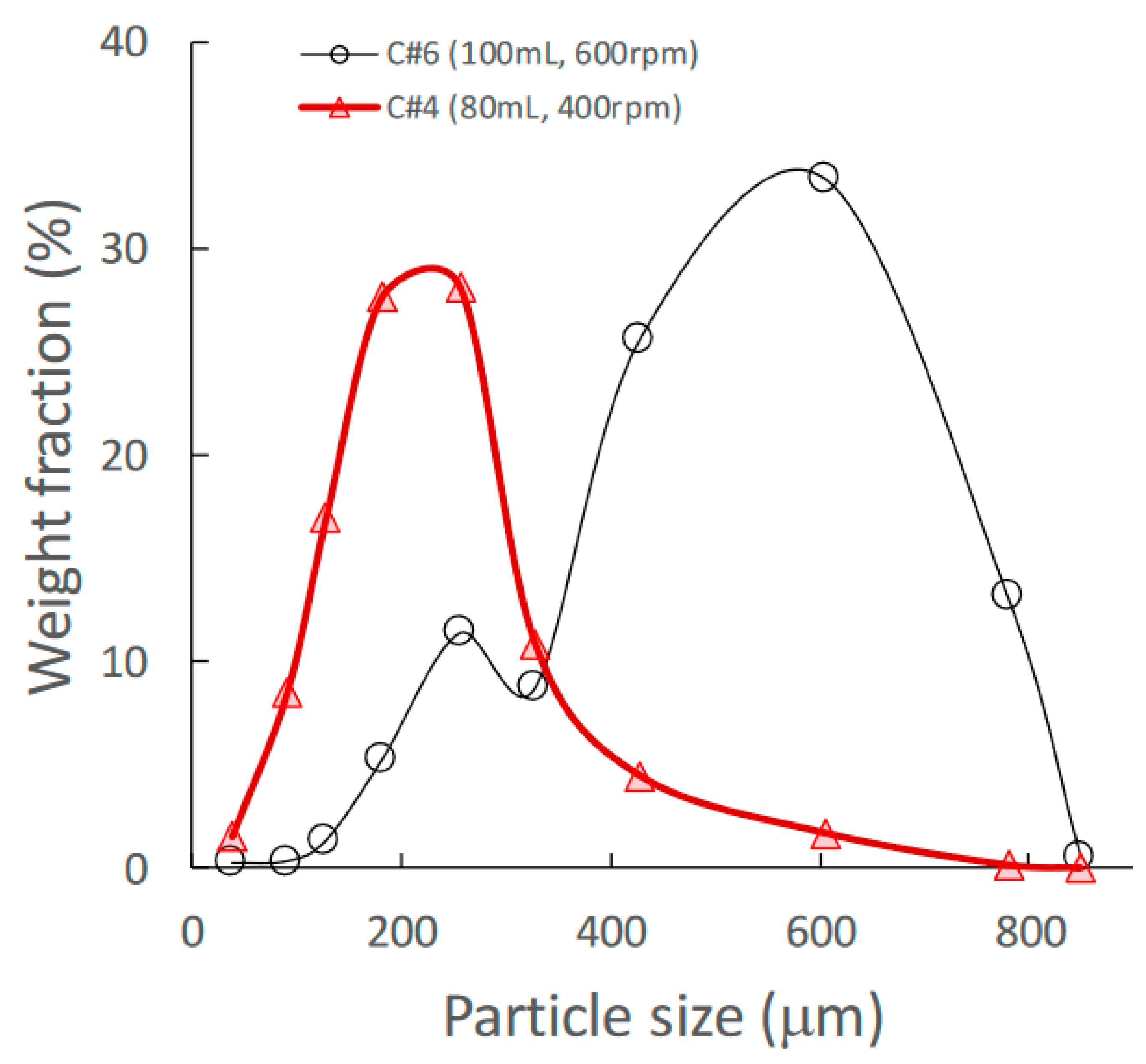
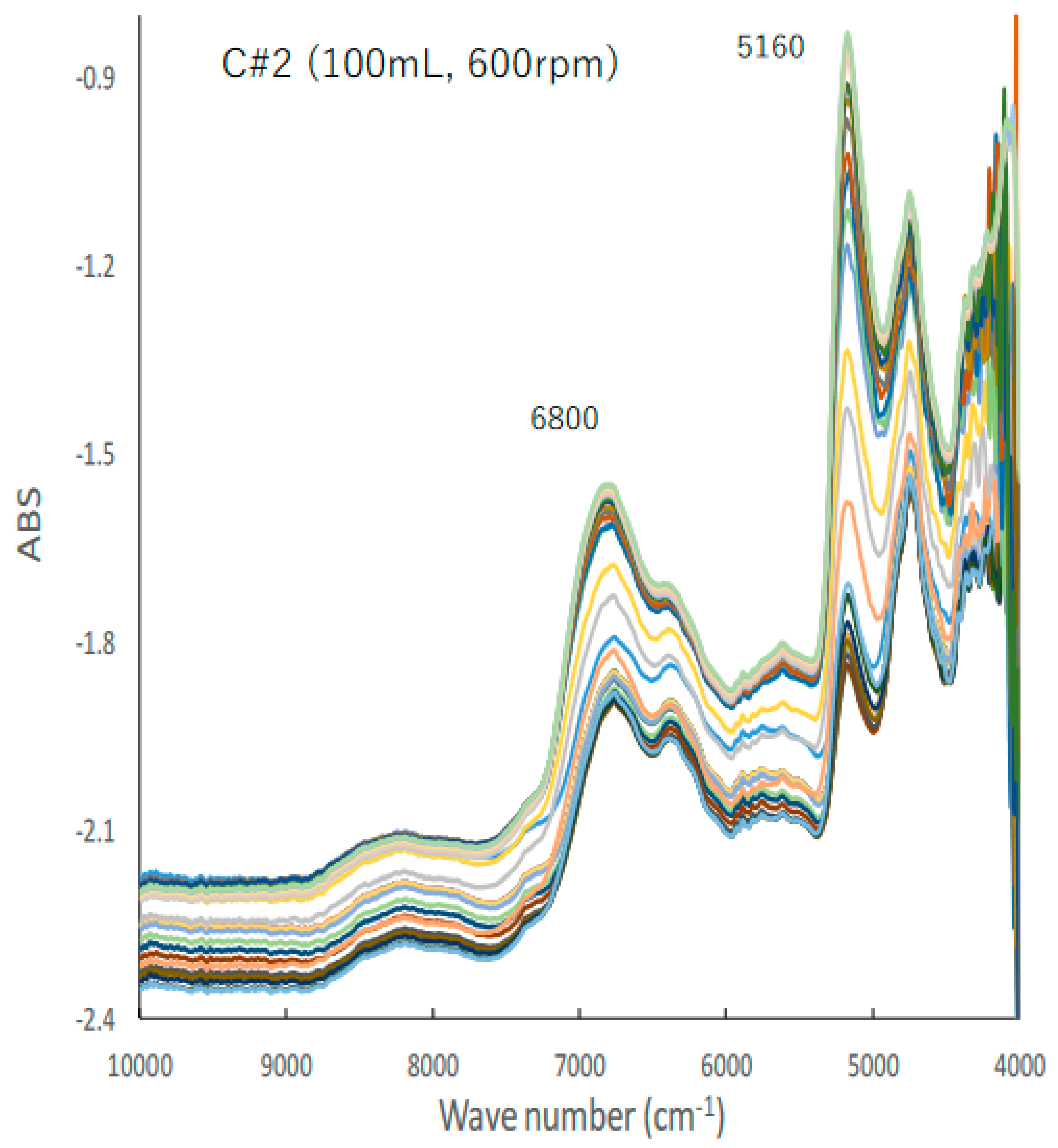
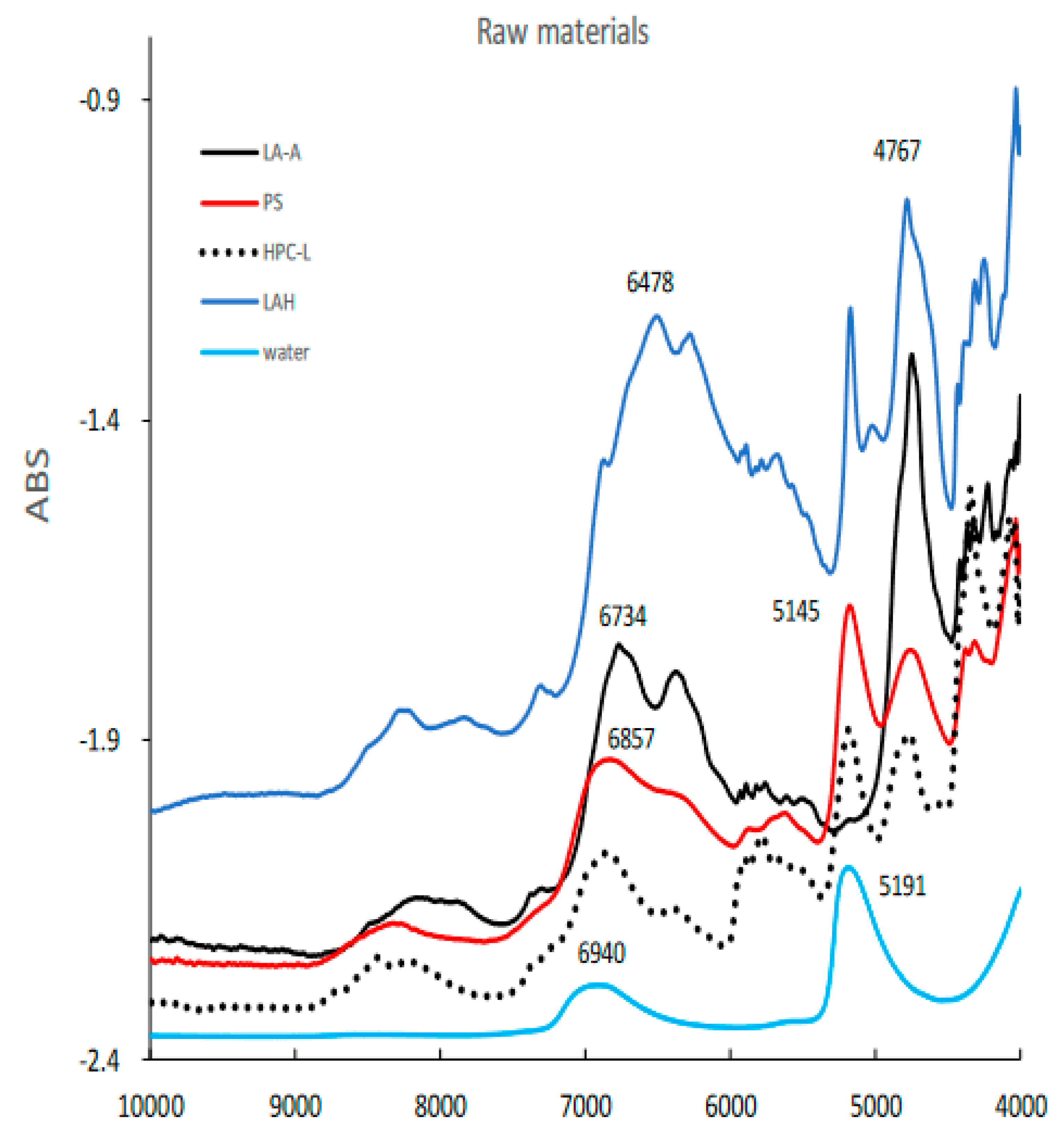


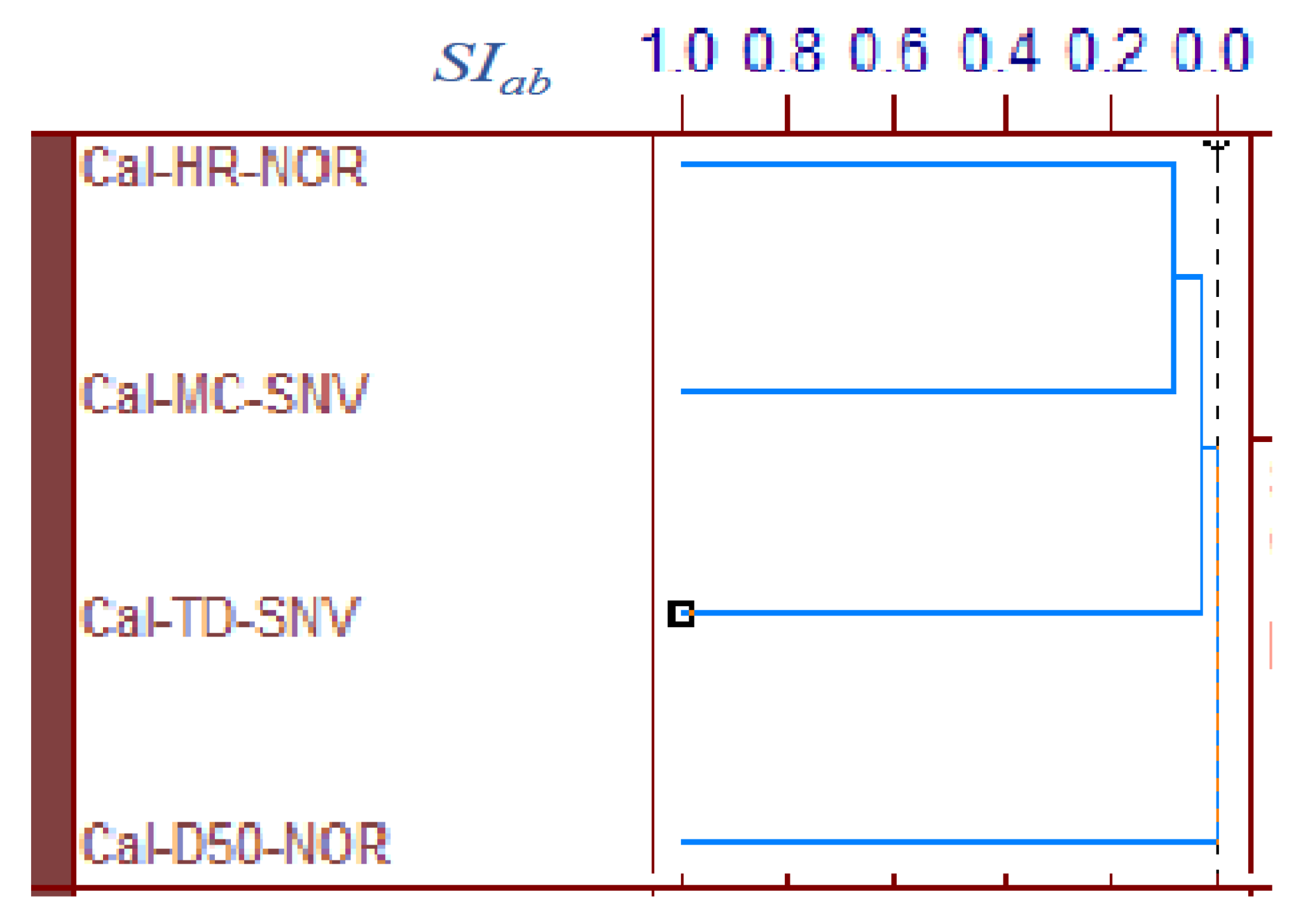

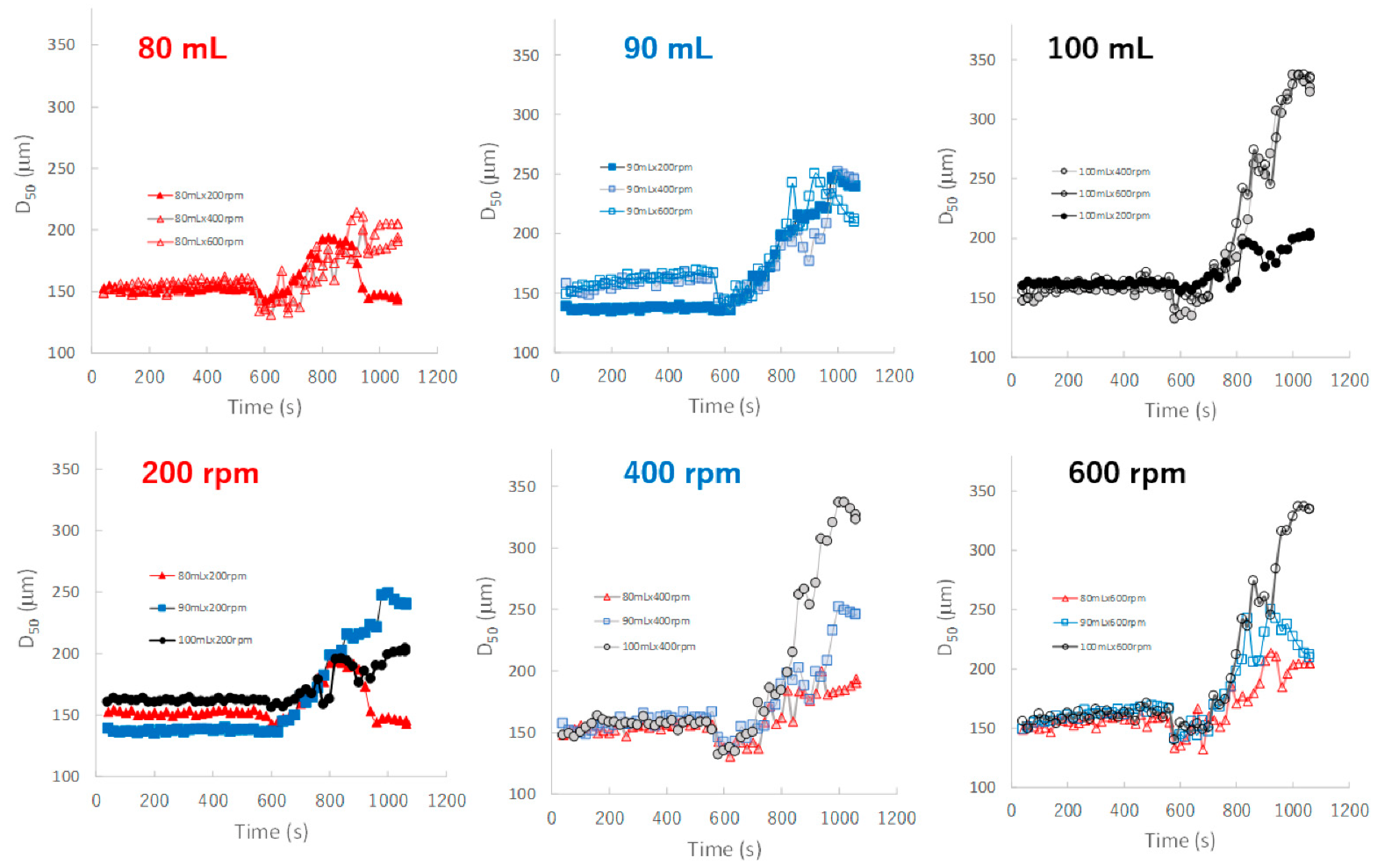

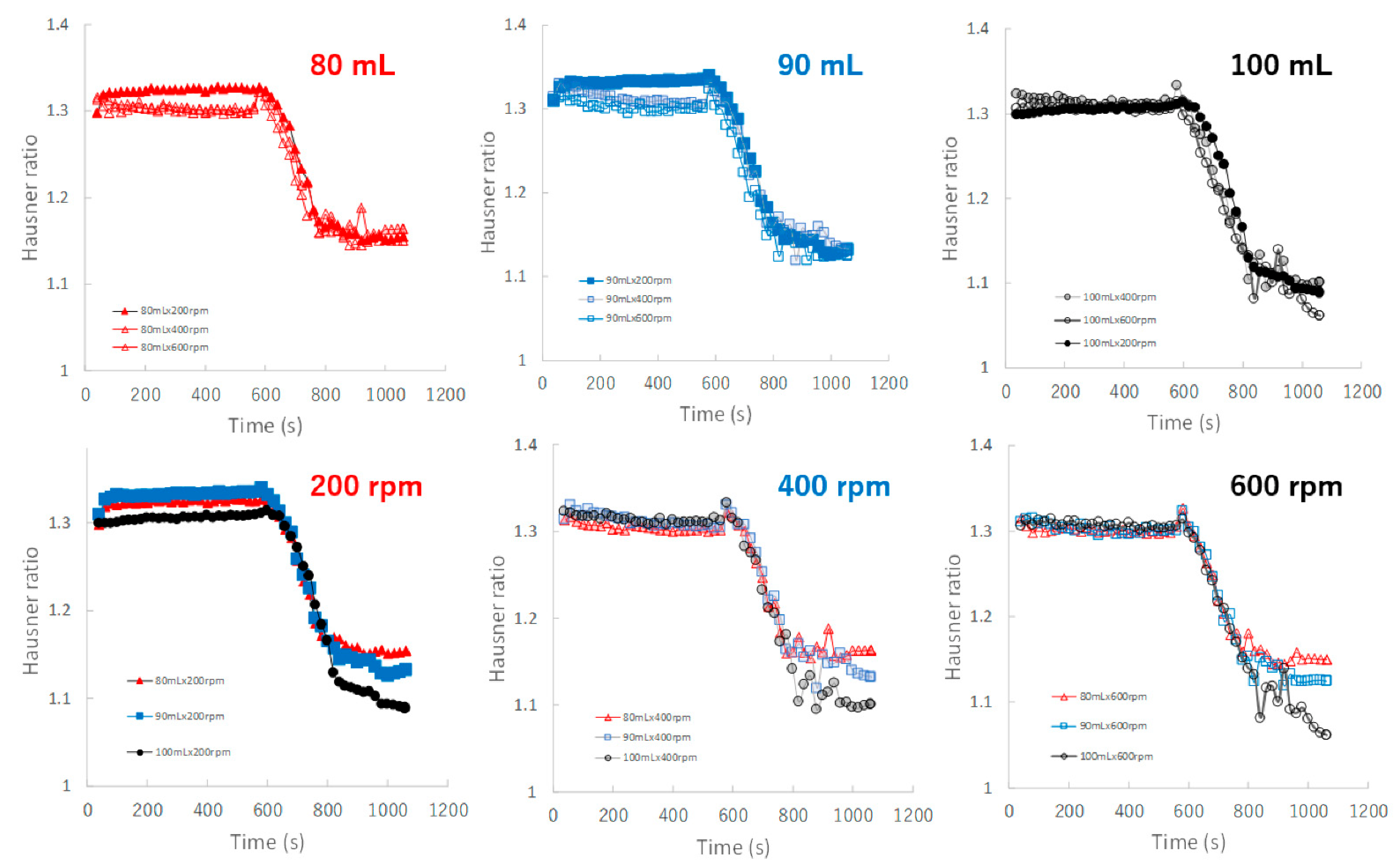
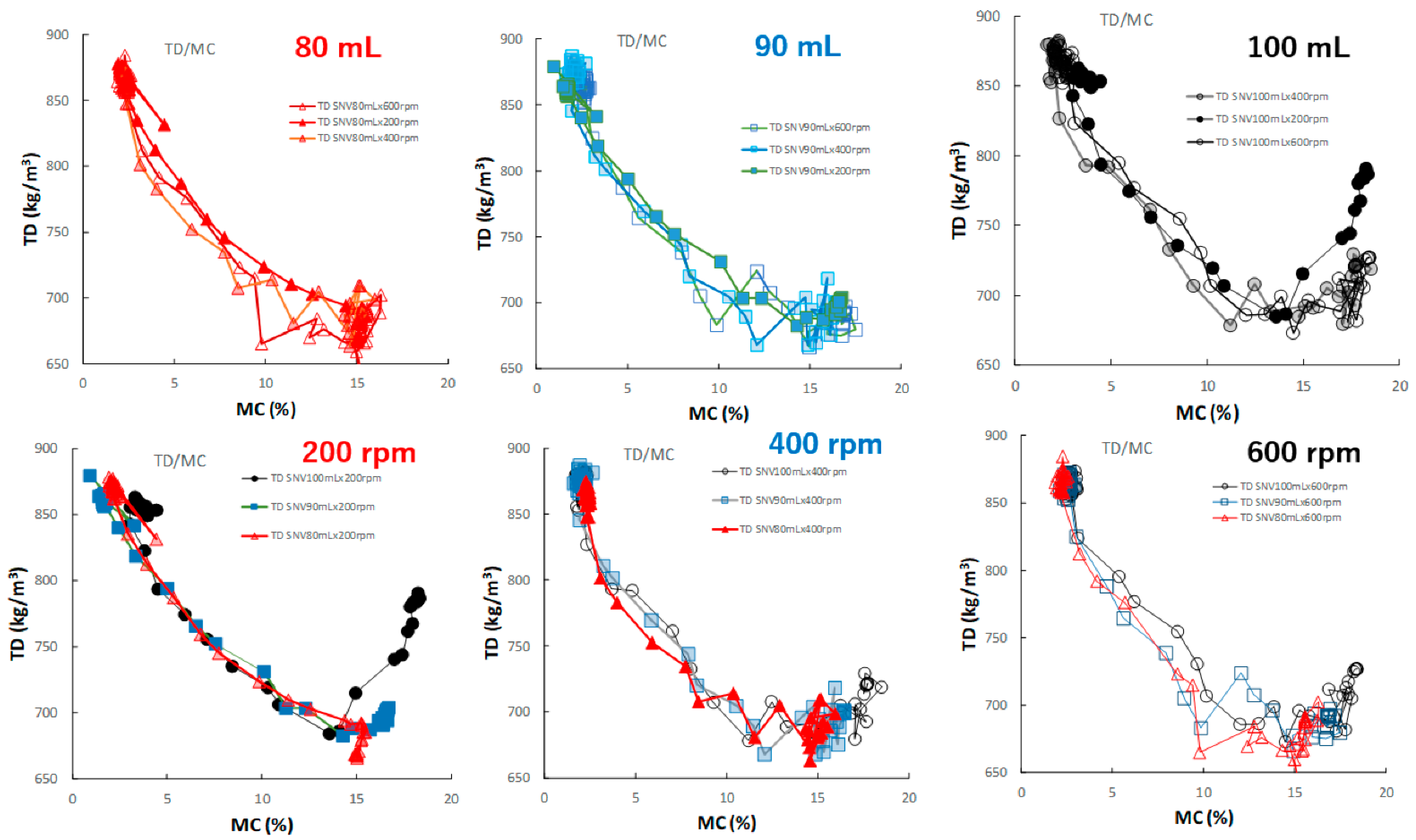
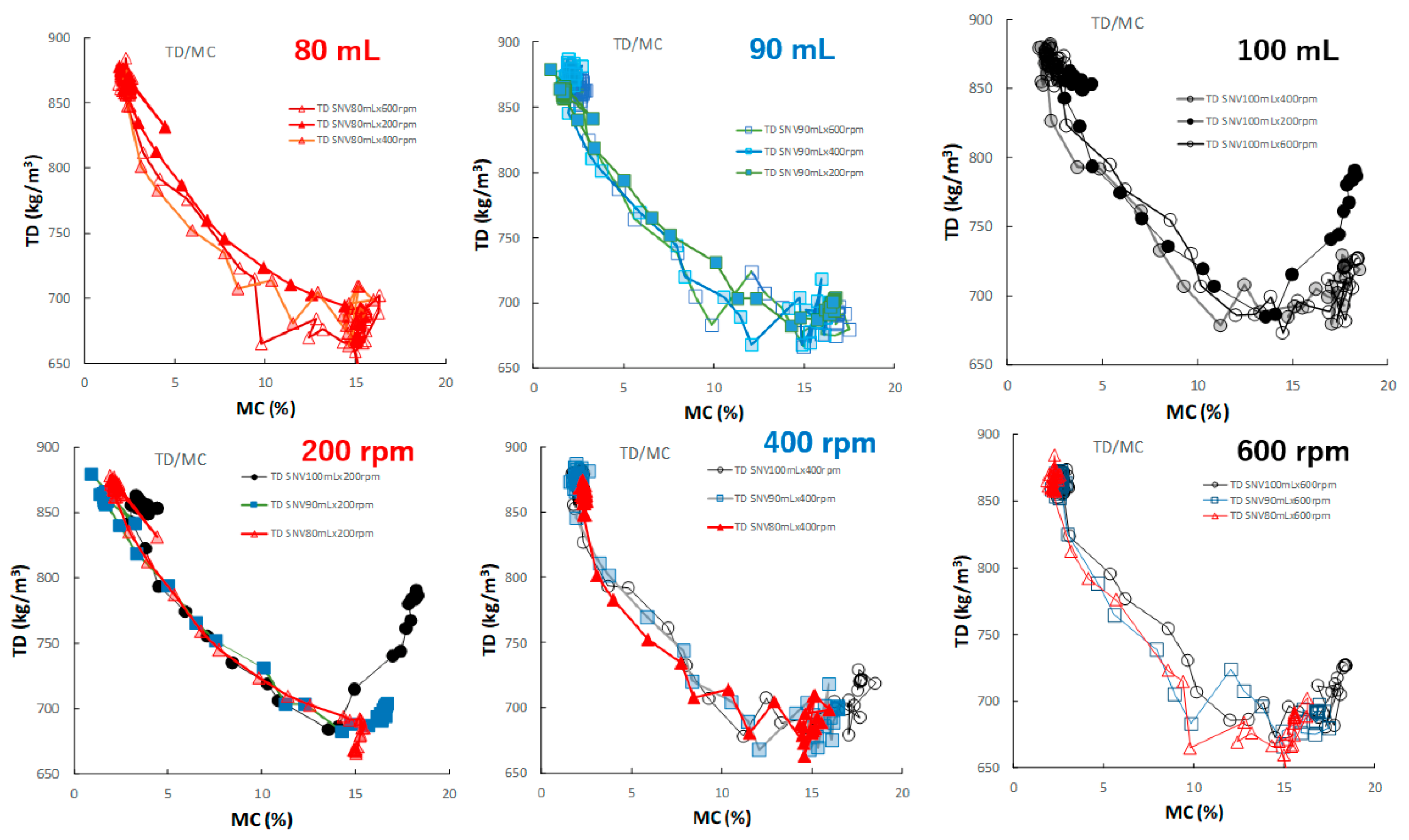
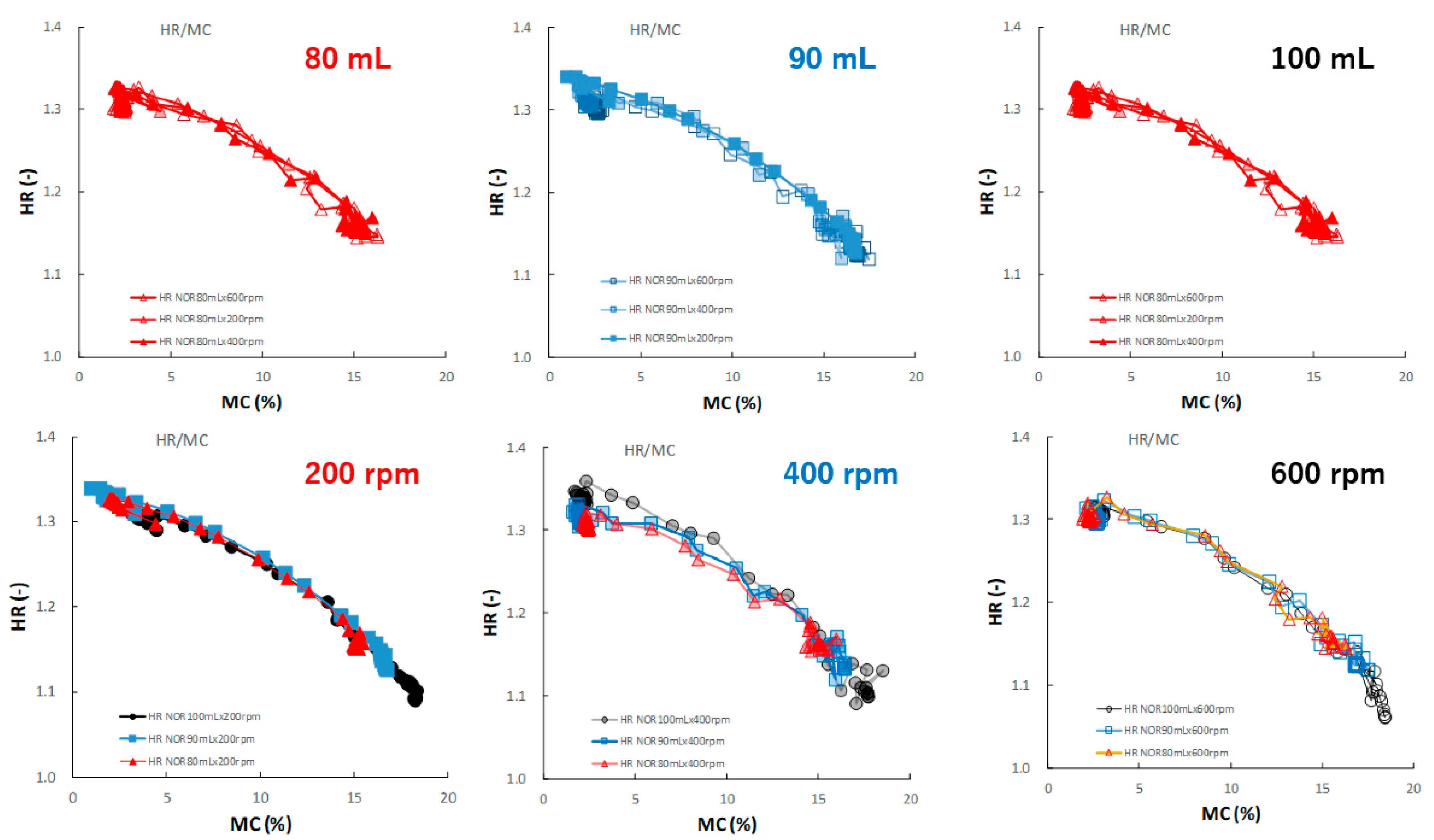

| No | 1 | 2 | 3 | 4 | 5 | 6 | 7 | 8 | 9 | 10 | 11 | 12 |
|---|---|---|---|---|---|---|---|---|---|---|---|---|
| Powder mixture (g) | 500 | 500 | 500 | 500 | 500 | 500 | 500 | 500 | 500 | 500 | 500 | 500 |
| Time (s) | Adding water amount (mL) | |||||||||||
| 600 | 20 | 20 | 20 | 20 | 20 | 20 | 20 | 20 | 20 | 20 | 20 | 20 |
| 660 | 20 | 20 | 20 | 20 | 0 | 0 | 0 | 20 | 20 | 20 | 20 | 20 |
| 720 | 20 | 20 | 20 | 20 | 20 | 20 | 20 | 20 | 20 | 20 | 20 | 20 |
| 780 | 20 | 20 | 20 | 20 | 0 | 0 | 0 | 20 | 20 | 20 | 20 | 20 |
| 840 | 20 | 20 | 10 | 0 | 20 | 20 | 10 | 10 | 20 | 20 | 10 | 20 |
| 960 | 0 | 0 | 10 | 0 | 20 | 20 | 10 | 0 | 0 | 0 | 0 | 0 |
| 1020 | 0 | 0 | 0 | 0 | 5 | 5 | 10 | 0 | 0 | 0 | 0 | 0 |
| 1200 | 0 | 0 | 0 | 0 | 0 | 5 | 10 | 0 | 0 | 0 | 0 | 0 |
| 1320 | 0 | 0 | 0 | 0 | 0 | 5 | 0 | 0 | 0 | 0 | 0 | 0 |
| 1440 | 0 | 0 | 0 | 0 | 0 | 5 | 0 | 0 | 0 | 0 | 0 | 0 |
| Total | 100 | 100 | 100 | 80 | 85 | 100 | 80 | 90 | 100 | 100 | 90 | 100 |
| Stirring (rpm) | 600 | 600 | 200 | 400 | 600 | 600 | 400 | 400 | 400 | 400 | 200 | 200 |
| Chopper (rpm) | 2000 | 2000 | 2000 | 2000 | 2000 | 2000 | 2000 | 2000 | 2000 | 2000 | 2000 | 2000 |
| MC [%] | 18.1 | 18.2 | 16.5 | 15.8 | 16.1 | 18.2 | 15.8 | 17.1 | 18.1 | 18.2 | 17.2 | 18.2 |
| D50 [μm] | 337 | 346 | 166 | 142 | 218 | 332 | 161 | 192 | 371 | 311 | 170 | 193 |
| TD [kg/m3] | 721 | 739 | 720 | 702 | 654 | 659 | 621 | 690 | 726 | 731 | 716 | 812 |
| HR [-] | 1.08 | 1.05 | 1.11 | 1.17 | 1.11 | 1.06 | 1.12 | 1.18 | 1.09 | 1.09 | 1.12 | 1.12 |
| No | 1 | 2 | 3 | 4 | 5 | 6 | 7 | 8 | 9 |
|---|---|---|---|---|---|---|---|---|---|
| Powder mixture (g) | 500 | 500 | 500 | 500 | 500 | 500 | 500 | 500 | 500 |
| Time (s) | Adding water amount (mL) | ||||||||
| 600 | 20 | 20 | 20 | 20 | 20 | 20 | 20 | 20 | 20 |
| 660 | 20 | 20 | 20 | 20 | 20 | 20 | 20 | 20 | 20 |
| 720 | 20 | 20 | 20 | 20 | 20 | 20 | 20 | 20 | 20 |
| 780 | 20 | 20 | 20 | 20 | 20 | 20 | 20 | 20 | 20 |
| 840 | 20 | 10 | 0 | 20 | 10 | 0 | 20 | 10 | 0 |
| Total | 100 | 90 | 80 | 100 | 90 | 80 | 100 | 90 | 80 |
| Stirring (rpm) | 600 | 600 | 600 | 400 | 400 | 400 | 200 | 200 | 200 |
| Chopper (rpm) | 2000 | 2000 | 2000 | 2000 | 2000 | 2000 | 2000 | 2000 | 2000 |
| MC | PTM | LV | CPV | SECV | PRESS Val | γ2Val | SEC | PRESS Cal | γ2Cal | |
| 1st | 5 | 91.0 | 0.953 | 109 | 0.983 | 0.836 | 79.6 | 0.987 | ||
| 2nd | 6 | 75.5 | 1.164 | 162 | 0.974 | 0.815 | 75.0 | 0.988 | ||
| MCS | 5 | 83.5 | 0.687 | 56.6 | 0.991 | 0.490 | 27.4 | 0.996 | * | |
| NOR | 5 | 96.4 | 0.838 | 84.2 | 0.987 | 0.620 | 43.8 | 0.993 | ||
| SNV | 5 | 83.1 | 0.673 | 54.4 | 0.991 | 0.465 | 24.6 | 0.996 | ** | |
| D50 | PTM | LV | CPV | SECV | PRESS Val | γ2Val | SEC | PRESS Cal | γ2Cal | |
| 1st | 4 | 90.9 | 49.4 | 293400 | 0.777 | 47.2 | 256121 | 0.808 | ||
| 2nd | 4 | 66.0 | 59.3 | 421436 | 0.669 | 51.4 | 303263 | 0.767 | ||
| MCS | 4 | 82.1 | 44.8 | 240431 | 0.824 | 38.2 | 167447 | 0.879 | ||
| NOR | 4 | 96.1 | 39.5 | 187381 | 0.864 | 33.4 | 128083 | 0.909 | ** | |
| SNV | 4 | 81.6 | 44.7 | 240091 | 0.824 | 38.1 | 167006 | 0.880 | * | |
| TD | PTM | LV | CPV | SECV | PRESS Val | γ2Val | SEC | PRESS Cal | γ2 Cal | |
| 1st | 1 | 66.0 | 60.5 | 439611 | 0.370 | 59.2 | 414126 | 0.429 | ||
| 2nd | 1 | 30.5 | 60.6 | 440422 | 0.370 | 58.7 | 407014 | 0.445 | ||
| MCS | 1 | 76.4 | 56.5 | 383096 | 0.497 | 55.2 | 359240 | 0.541 | ||
| NOR | 6 | 96.6 | 48.9 | 287250 | 0.683 | 32.0 | 115478 | 0.879 | * | |
| SNV | 4 | 80.2 | 45.0 | 242956 | 0.737 | 29.5 | 100087 | 0.896 | ** | |
| HR | PTM | LV | CPV | SECV | PRESS Val | γ2Val | SEC | PRESS Cal | γ2Cal | |
| 1st | 4 | 90.7 | 0.0331 | 0.132 | 0.920 | 0.0301 | 0.104 | 0.937 | ||
| 2nd | 4 | 66.8 | 0.0398 | 0.190 | 0.884 | 0.0322 | 0.119 | 0.928 | ||
| MCS | 2 | 79.5 | 0.0299 | 0.108 | 0.935 | 0.0281 | 0.0926 | 0.945 | ||
| NOR | 3 | 96.0 | 0.0303 | 0.110 | 0.934 | 0.0277 | 0.0890 | 0.947 | ** | |
| SNV | 2 | 78.9 | 0.0299 | 0.107 | 0.936 | 0.0281 | 0.0922 | 0.945 | * |
| MC [%] | D50 [μm] | TD [kg/m3] | HR | |
|---|---|---|---|---|
| SEP | 1.66 | 25.1 | 42.0 | 0.0721 |
| PRESS | 96.2 | 22018 | 61639 | 0.182 |
| γ2 | 0.985 | −0.115 | 0.823 | 0.873 |
| LV | 5 | 4 | 4 | 3 |
| Slope | 0.928 | −0.138 | 0.833 | 0.554 |
| Intercept | −0.515 | 180 | 110 | 0.528 |
| ModelESS | 225.0 | 68.7 | 257.2 | 70.0 |
| PTM | SNV | NOR | SNV | NOR |
Publisher’s Note: MDPI stays neutral with regard to jurisdictional claims in published maps and institutional affiliations. |
© 2022 by the authors. Licensee MDPI, Basel, Switzerland. This article is an open access article distributed under the terms and conditions of the Creative Commons Attribution (CC BY) license (https://creativecommons.org/licenses/by/4.0/).
Share and Cite
Koyanagi, K.; Ueno, A.; Sasaki, T.; Otsuka, M. Real-Time Monitoring of Critical Quality Attributes during High-Shear Wet Granulation Process by Near-Infrared Spectroscopy Effect of Water Addition and Stirring Speed on Pharmaceutical Properties of the Granules. Pharmaceuticals 2022, 15, 822. https://doi.org/10.3390/ph15070822
Koyanagi K, Ueno A, Sasaki T, Otsuka M. Real-Time Monitoring of Critical Quality Attributes during High-Shear Wet Granulation Process by Near-Infrared Spectroscopy Effect of Water Addition and Stirring Speed on Pharmaceutical Properties of the Granules. Pharmaceuticals. 2022; 15(7):822. https://doi.org/10.3390/ph15070822
Chicago/Turabian StyleKoyanagi, Keita, Akinori Ueno, Tetsuo Sasaki, and Makoto Otsuka. 2022. "Real-Time Monitoring of Critical Quality Attributes during High-Shear Wet Granulation Process by Near-Infrared Spectroscopy Effect of Water Addition and Stirring Speed on Pharmaceutical Properties of the Granules" Pharmaceuticals 15, no. 7: 822. https://doi.org/10.3390/ph15070822
APA StyleKoyanagi, K., Ueno, A., Sasaki, T., & Otsuka, M. (2022). Real-Time Monitoring of Critical Quality Attributes during High-Shear Wet Granulation Process by Near-Infrared Spectroscopy Effect of Water Addition and Stirring Speed on Pharmaceutical Properties of the Granules. Pharmaceuticals, 15(7), 822. https://doi.org/10.3390/ph15070822







